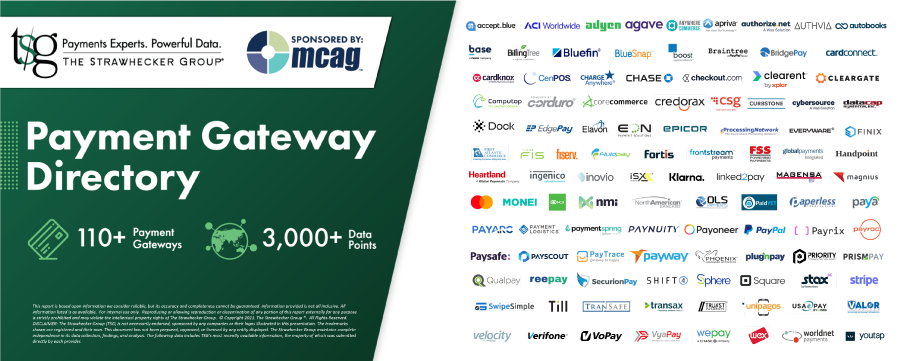As the global economy continues to emerge from the global COVID-19 pandemic, the online shopping trends that accelerated as a result are here to stay and the role of payment gateways has become increasingly crucial. High functioning and efficient payment gateways are the backbone of the eCommerce payments ecosystem, and as they always have been, gateways will be tested this holiday season as they enable transactions for what will likely be the largest online shopping season thus far. In addition to consistent uptime, factors such as transaction speed, authorization failure rate, API accessibility, ease of onboarding, methods of payment supported, vertical and geographic reach, and overall cost are all important qualifying attributes in evaluating the strength of a payment gateway.
Through TSG’s Gateway Enterprise Metrics (GEM) platform and the separate annual Payment Gateway Directory sponsored by MCAG, TSG has continually seen diversity in capabilities and performance of gateways and how they’ve impacted businesses as commerce continually moves online. As part of our continuous research, TSG is pleased to share a few interesting notes and key trends uncovered from this year’s Payment Gateway Directory sponsored by MCAG, which contains over 110 payment gateways of varying sizes.

Key Insights:
- Represented Verticals – General retail was once again the most widely explicitly served vertical, with over half of all gateways (54%) focusing on the vertical. Restaurant (33%), Healthcare (27%), and Education (19%), additionally made-up meaningful percentages of industry focus for the analyzed gateways.
- APIs – 65% of gateways analyzed have open developer center pages with full access to their APIs available without needing credentials, up from 48% last year. 19% of the gateways were classified as having “quasi-public” API sets where APIs are not inaccessible to third parties but require an additional step such as filling out API access forms or creating sandbox accounts in order to access.
- Setup Fees and Monthly Costs – Of the analyzed gateways, 29% charged a gateway setup fee and 51% charged a monthly fee. This is largely consistent with the findings last year, where 24% and 50% were identified to charge setup fees and monthly fees respectively.
- Geographic Focus – Most gateways analyzed in this year’s directory focus on the North American region. Over 36% have the ability to serve Europe with additional sizable representation in the directory from gateways that serve the APAC and Latin American regions.
- Corporate Structure – 32% of gateways were identified to be operated as or subsidiaries of public companies. While it may be a popular assumption that the most used and trafficked online gateways are operated by the largest public corporations in the payments industry, nearly 7 out of 10 gateways represented in the 2021 directory were identified to be private and may indicate that a substantial amount of gateway volume is handled by independently operated and lesser-known entities.
- Reporting Functionality – Virtually all analyzed gateways (98%) offer some sort of reporting functionality online with a dashboard with a slightly smaller amount (90%) of gateways that include a reporting API that allows merchants or integrators to query for reporting data on-demand.
- Cryptocurrency Merchant Acceptance – As the conversation of cryptocurrency merchant acceptance continues to evolve, it was evident that widespread adoption is still far away. Only 9% of gateways were identified to offer support for cryptocurrency payments.
Download a preview of TSG’s Payment Gateway Directory or email us with questions; we look forward to working with you.